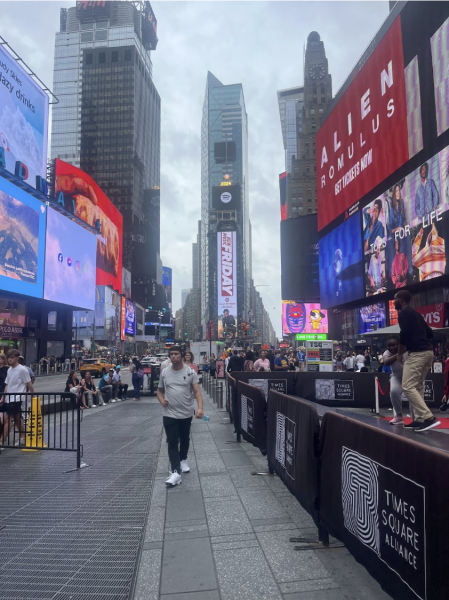America teeters on brink of a recession
Over the past year, economists have been noticing trends and patterns regarding the level of economic growth that have led to speculation that a national economic recession is approaching within the next year.
A Forbes article written by financial copywriter David Rodeck defines a recession as “a significant decline in economic activity that lasts for months or even years.” Declaring that a country has entered a recession does not indicate that conditions are going to drastically worsen or deteriorate, but it essentially declares the economy is at a level of weakness it rarely enters. The past several recessions the country has experienced have been unexpected but for a variety of reasons this current instance seems to be predicted.
A major point of interest is inflation, where current evidence suggests a recession. According to the U.S. Inflation Calculator, which calculates data from the Labor Department’s Bureau of Labor Statistics’ monthly consumer price index (CPI), from 2013 to 2019, inflation rates have risen no higher than 2.3%, but from 2021 to 2023, they have been at a minimum of 6.4%, almost three times as high. Due to major product shortages in recent years, inflation has risen to the highest rate it has been at since 1982.
The data is not limited to inflation, however. Unemployment rates are not necessarily in a bad spot, sitting at 3.4% according to Trade Economics, but worry comes from the drastic nature of those numbers in recent years. Following the unprecedented spike in unemployment in 2020, rates made a quick recovery, and that creates worry as to the stability of the job market.
One of the biggest concerns is the gross federal debt to gross domestic product (GDP) ratio. According to Trade Economics, the United States’ gross federal debt to GDP sits at an all-time U.S. high of over 130%. From 2013 to 2019, this ratio did not surpass 107.2%, but from 2020 to right now, it is yet to duck under 125%.
Prices and various interest rates associated with housing prices, mortgages, bank loans and student loans are also seeing increases that add to the list of concerns about a recession.
If economists decide that this data is confirming a recession, this will mean a variety of things for the American people, especially young adults.
Personal finance teacher Renee Grisch teaches her students all about the economy and ways to handle their own finances and has developed her own worries regarding the economy as her students will soon enter it.
“If we’re in a recession, the main concern for young people is the bringing back of jobs and the salaries that match those jobs. In recessions, we lose different types of jobs and they don’t come back for a long time,” Grisch said. “Generally, in the economy, in a recession where we go into debt, it’s unknown how young people will pay off that debt, and that’s not as much of a problem for my generation as it is for younger ones.”
In a recession where interest rates, inflation and unemployment increase, companies cannot afford to pay as many employees while also continuing to consume as they do. This then leads to unemployment, and as more people have less money, the debt increases. As the economy recovers, however, it becomes difficult for people to secure well-paying jobs in order to pay off this debt, as companies seeking workers are also struggling with debt of their own. This chain of events leads to an unfavorable job market and lots of lingering debt for many Americans.
This data points heavily towards a recession, and the economy is transpiring in a way that appears to be indicative of one as well. Despite all of this, there is one final piece of information that is crucial in economists’ minds in determining if this specific instance of negative economic growth could be indicative of a recession.
The COVID-19 pandemic caused problems globally for the economy. Between major product shortages, freezing of debt and interest rates and a major spike in unemployment, the pandemic caused so many unforeseen impacts on the economy that professionals are still determining what is simply the aftermath of COVID-19 and what is an apparent standalone recession.
“I think the most prevalent reason as to why conditions have worsened is that we are still at the tail end of COVID. During COVID, pretty much everybody stopped making payments such as student loans,” Grisch said. “Banks said, ‘Hey, you don’t have to pay your car loans, and you don’t have to pay your rent,’ and we went from that to spending massive amounts of money after they set us free. I think this is all part of that whole wave of [the] aftermath that’s coming through.”
This consideration of COVID as a reason for the economy’s behavior is apparent in economists’ predictions, as the time frame for a recession has continued to be pushed back later into the year or into future years over time.
Between various instances of economic data and the behavior of the economy, many would make the claim that the U.S. is entering a recession. However, given that the country is still rebounding from the unprecedented detriment to the economy that was the COVID-19 pandemic, it is simply too unclear to give a definitive answer. It is still incredibly important to be prepared because of this instability.

Name: Kevin Sigrist
Position: Advisor’s Assistant
Graduation year: 2024
A few sentences about me: Hi, I’m Kevin....









